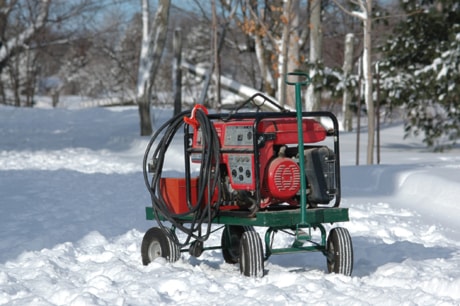Most of us live just an extension cord away from the stone age.
Cut off our electric power — even for just a day — and we’re pretty much helpless.
But it doesn’t have to be this way. Generators have been getting smaller, lighter, more powerful and less expensive during the last 10 years.
It’s now more practical than ever for individual Canadian householders to meet their own emergency power needs, and success begins by understanding your options.
Size, portability and power quality are the main issues to look at, and you need to begin with a calculator in hand.
Watts are the universal yardstick of power consumption in the electrical world, and watts are how generator sizes are rated.
Add up the wattage of all the things you want to use during an outage, add an allowance for extra capacity, and that’s the size of generator you need. Sounds simple enough, but there are complications.
First of all, not all electrical items have wattage ratings stamped on them.
Voltage and amperage numbers, however, must be shown by law on electrical devices, and that’s a good thing.
Simply multiply voltage and amperage specs to get a wattage consumption figure.
Next, you need to realize that some appliances draw a lot more power during start up than they do while running. Sounds complicated? Not really. Here’s how the numbers shake down in the real world.
Most people find a 3,500 watt generator sufficient for bare-bones household needs.
A 5,000 to 6,000 watt model offers more options, though it’s still very much basic power.
Completely powering a modern home during an extended outage can easily require 15,000 watts or more (even without any electrical heating needs ) and while this used to be beyond the scope of what’s reasonable for most people, not so now.
Prices of large, stationary, residential back-up generators have dropped to the point where a 14,000 watt model now sells for about $4,000; a 20,000 watt system just over $5,000. These units can’t be moved around, but they do offer the lowest cost-per-watt figures of all generators, along with quiet operation, automatic switching and a quality of power output that’s worth taking a closer look at.
Power quality isn’t an obvious issue when selecting a generator, but you need to consider it.
In fact, it’s absolutely crucial if you’re buying a generator to protect you during an extended outage. The kind of electrical items we all have in our homes these days is the reason why.
Although standard generators put out alternating current (AC) power at a specific voltage (120 volts, 240 volts or both), the electricity they deliver is substantially different than what comes out of your household wall socket.
True AC power involves a smooth rising and falling of voltage levels at a certain frequency. This is why it’s called “alternating” current.
If you were to analyze this power on the screen of an oscilloscope, it would look like a smooth and consistent sine-wave.
Conventional generators, on the other hand, only approximate true sine wave output in a way that’s coarse and blocky.
This is perfectly acceptable for water heaters, large electric motors, cooking appliances, water pumps, etc., though the situation is different when it comes to sensitive electronics. These devices need more refinement.
Computers, stereos, DVD players, TVs, Internet access equipment and even some cordless tool battery chargers need smooth sine wave power, and that’s why a growing number of generator manufacturers offer models specifically designed to produce power that’s identical to what comes from the grid.
These are often called “inverters”, and though cost more than bargain-basement generators, they offer another advantage in addition to clean power.
Inverters are often equipped with a variable load feature that controls motor speed depending on the electrical load demanded. If you’re calling on only 10 per cent of the inverter’s capacity, engine speed will run just slightly more than an idle; 50 per cent demanded current draw and the motor will run half speed. Full demand, full engine speed.
This translates into quieter operation, greatly reduced fuel consumption and a much more pleasant experience next time an extended power outage strikes.
Steve Maxwell is Canada’s award-winning home improvement expert, and technical editor of Canadian Home Workshop magazine. Sign up for his free homeowner newsletter at www.stevemaxwell.ca
